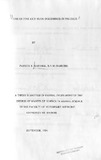| dc.description.abstract | Experiments were carried out to determine the composition of the rice milling by-products produced in Kenya and the effect of including fine rice bran in the diets for growing-finishing pigs on growth performance, nutrient digestibilities and carcass quality.
Samples of rice milling by-products were analyzed for proximate and mineral composition. The by-products analyzed in the order of their recovery from the mills were: rice hulls (RH), coarse rice bran (CRB), fine rice bran (FRB) , fine broken rice (FBR) and coarse broken rice (CBR). Moisture ranged from 9.58 (CRB) to 11.93% (CBR), crude protein from 3.08 (RH) to 10.80% (FRB), crude fibre from 1.39 (CBR) to 41.70% (RH), ether extract from 1.39 (RH) to 14.21% (FRB), ash from 1.10 (CBR) to 31.77% (RH) and nitrogen free extract (NFE) from 12.46 (RH) to 74.65% (CBR). Calcium ranged from 0.07 (CBR) to 0.14% (CRB), phosphorus from 0.63 (CRB) to 1.08% (CBR) and zinc from 9 (CBR) to 40 ppm (FBR). In general, it was observed that the higher the proportion of endosperm in the rice milling by-products, the higher the NFE and the lower the protein, fibre, fat and ash contents.
A feeding trial with 36 pigs (18 males and 18 females) on sorghum based diets containing 0, 10, 20, 30, 40 and 50% levels of fine rice bran was conducted. The results showed that inclusion of rice bran up to a level of 50% in diets for growing-finishing pigs had no significant effect (p > 0.05) on weight gains, feed conversion efficiencies, dressing-out percentage, carcass length and back fat measurements. However, boars had a significantly lower (p < 0.05) dressing-out percentage than gilts. The apparent digestibilities of dry matter, energy, protein and fat for growing pigs showed a significant linear increase (p < 0.05) as the level of rice bran in the diets increased.
The gross margin profit from pigs on diets containing 0, 10, 20, 30, 40 and 50% levels of fine rice bran was Ksh 731, 886, 940, 1038, 1129 and 1294 respectively. This indicates that fine rice can be used as a more economical substitute for sorghum in pig diets. It would however be important to determine pig performance at even higher levels of dietary rice bran. | en_US |



